Social listening is one of the easiest ways to track how a brand is perceived online. Besides in-house PR and marketing teams, there is another group that can benefit from social listening tools – public relations agencies.
If you’re a PR agency struggling to get a seat at the table and prove the effectiveness of your campaigns, we’ll show you how social media listening can help, including:
- Why is social listening key for PR agencies?
- 8 benefits of using social media monitoring
- How to use hashtag campaigns + examples
- How does creating a hashtag campaign work
- Mitigate and manage crises with social listening
- FAQ: Benefits of social listening
Want to create your social listening campaign right away? Set it all up with Prowly for 7 days free.
Why is social listening key for PR agencies?
PR agencies specialize in media relations, strategic communications, crisis management, and many other methods of promoting their clients’ brands.
And they can massively benefit from a social listening strategy, as it gives them an eye and an ear over their clients’ mentions:
1️⃣ Finding opportunities to react instantly by monitoring online mentions of your client, enabling immediate and proactive engagement in conversations, whether positive or negative.
2️⃣ Monitoring competitors around the clock by tracking branded terms, industry terms, campaigns, and hashtags to promptly respond and stay informed about their activities.
Monitoring allows you to stay up to date with what your major competitors are up to. If they slip up, you can stay in the loop and react accordingly on behalf of your client.
3️⃣ Gaining insights into the media landscape, identifying key journalists and their coverage areas to enhance media relations, facilitating more effective communication and better outcomes for clients.
4️⃣ Using tools like Prowly to tailor social listening for clients by customizing tracked keywords, monitoring locations (social media, websites), specifying brand mention notifications, and controlling the timing and format of alerts.
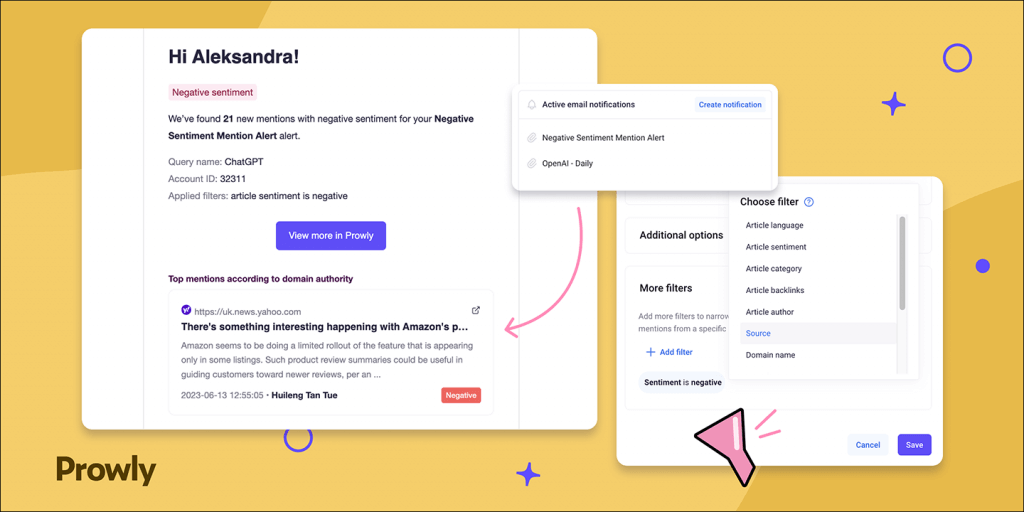
With Prowly, you can receive email notifications as frequently as you need: monthly, weekly, or daily, to stay informed about what people are saying about your clients’ brands.
Benefits of using social media monitoring
For PR agencies and in-house marketing and PR teams, social media monitoring can be very helpful in tracking online presence for themselves and their clients.
1️⃣ Real-time crisis management
When a crisis unfolds on social media, it happens in a matter of minutes.
One negative Tweet or comment can launch an avalanche of other negative comments. And while there are ways to put out these fires, it’s better to do so sooner rather than later.
👉🏼 Social monitoring lets you capture posts, comments and news in real-time so you can address them immediately. If you wait hours to react, it may already be too late (as you will read about later in this article, such was the case with Domino’s.).
2️⃣ Enhance audience understanding
One of the major benefits of social media listening is that you don’t have to rely on assumptions about your target audience. You get precise data on the platforms where they spend their time, the posts where they mention you, and their sentiment towards your brand.
👉🏼 This helps PR specialists create more effective communications plans and better represent clients in various media outlets.
3️⃣ Competitive intelligence
A tool such as Prowly lets you perform social media monitoring for any term that you can think of. If you’re a PR specialist representing the CRM company Hubspot, you could set up alerts for:
▪️ Hubspot
▪️ Hubspot alternatives
▪️ Hubspot review
▪️ CRM software
▪️ Salesforce
▪️ Zoho CRM
👉🏼 The point is, you can just as easily monitor competitor terms as you monitor your main brand name and industry terms. If a competitor has a new campaign brewing or the internet is giving them hell, you’ll be the first to know.
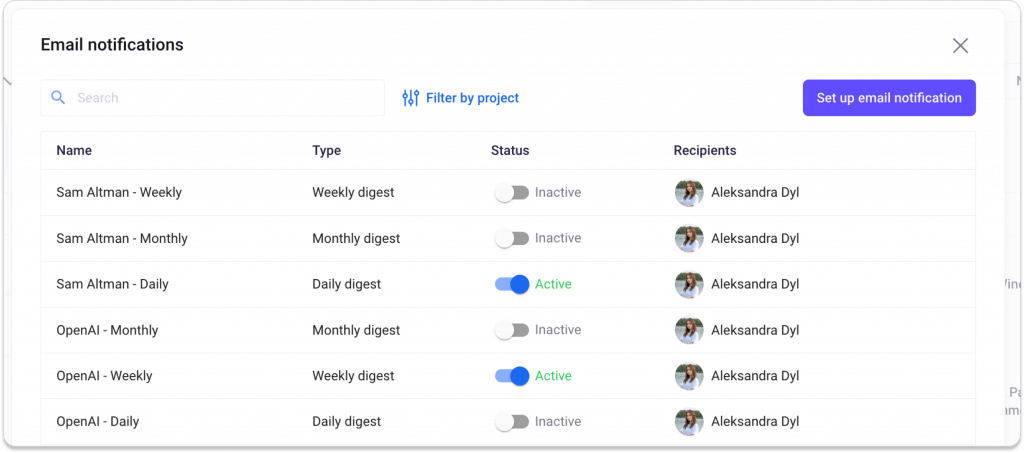
You can set up how often you want to be notified about specific mentions of competing brands and receive them directly in your mailbox.
4️⃣ Improved campaign effectiveness
You no longer need to rely on assumptions about what your customers like or dislike.
Your PR campaigns get better with social media monitoring because you have all the relevant data about your target audience.
👉🏼 This means you can plan your campaigns out more effectively, have clearer messaging and communication, and reach a better ROI on your campaigns.
P.S. You can learn all about how to use social listening to make your PR activities more effective from this comprehensive guide.
5️⃣ Identifying emerging trends
By monitoring relevant brand names and terms, you don’t just stay on the cutting edge.
You also get to see new trends emerging. For example, if you’ve been following email marketing trends in the past few weeks, you could have noticed new rules being introduced by Gmail and Yahoo! in the upcoming year.
👉🏼 Social listening and monitoring can show you what’s hot before it becomes hot.
6️⃣ Data-driven decision-making
Social listening isn’t just about tracking who said what; it’s about gaining data.
Imagine two scenarios:
- In the first one, you tell your client that their biggest competitor is more popular than them on social media.
- In the second one, you tell the client that based on sentiment analysis and media monitoring, your competitor is perceived more positively on Twitter, with 83% of their mentions being positive. Meanwhile, your client only has 33% positive mentions.
Now, the answer to what gives better insights is obvious.
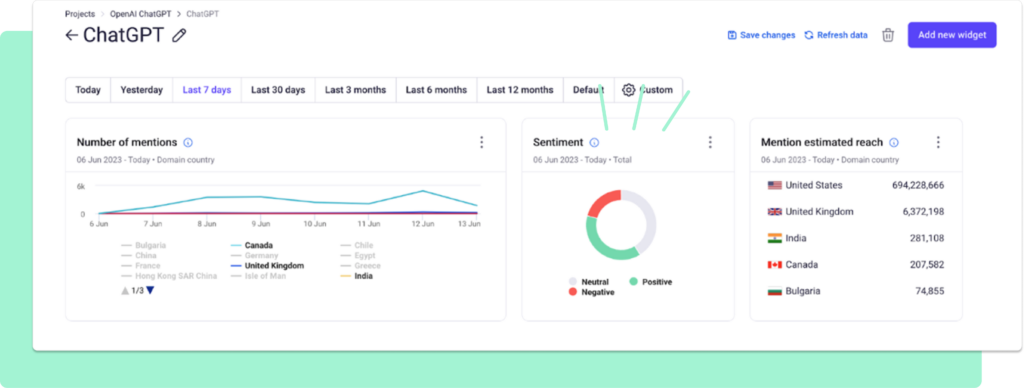
👉🏼 With social media listening software, you can make data-based PR decisions for your clients. On top of that, you get access to metrics such as Share of Voice and AVE. And you have access to it straight from your dashboard, no digging is needed.
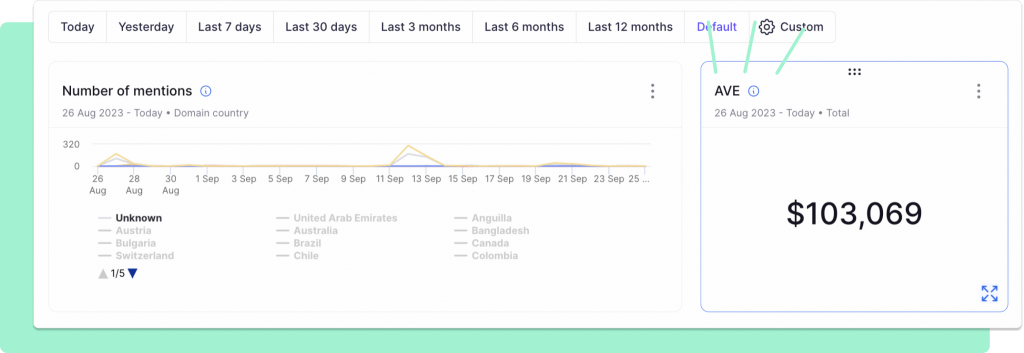
Start using data generated through social listening and monitoring tools for informed decision-making and provide a solid foundation for strategic PR planning and execution.
7️⃣ Targeted media outreach
When your PR agency reaches out to journalists, you’ll no longer have to shoot blindly. Thanks to social media listening platforms, you can reach out to the journalists who will make a difference in your campaigns.
Let’s say your client is a fishing rod brand and thanks to social listening, you find an outdoors journalist doing detailed reviews in different online magazines.
👉🏼 Next time your client has a product launch, you can create a personalized press release.
And even before that happens, you can message them using a platform such as Prowly to build a connection.
8️⃣ Brand perception analysis
Tools to monitor the digital space give you an accurate picture of your client’s brand:
- You can understand complex nuances of public sentiment.
- You can understand how customers perceive you, whether they have misconceptions or negative perceptions and then address them swiftly.
👉🏼 On top of that, you can analyze the domain authority of your media mentions – which is a score grading the “strength” of a website you got a mention from.
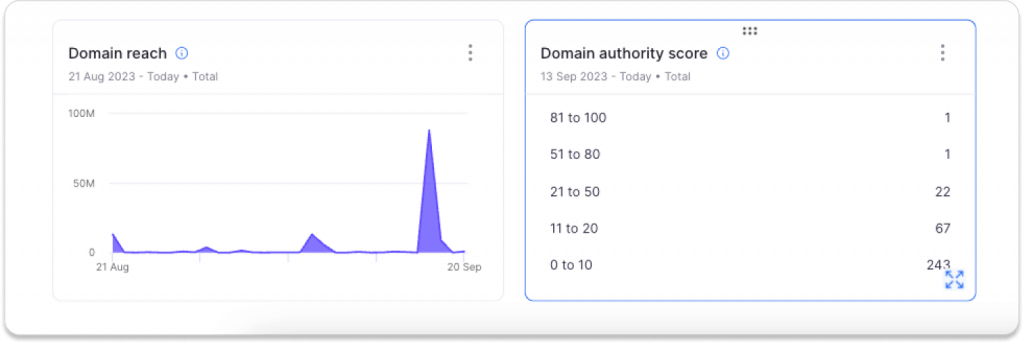
In Prowly, domain authority is structured in such a way that the lower the number is, the better the rank and the strength of a website. The closer the website is to #1, the stronger the rank. For example, a website with a domain rank of 10 is better than a website with a rank of 81.
How to use hashtag campaigns + examples
Hashtag campaigns are exactly what the name sounds like: a brand launches a unique hashtag for a campaign and asks (potential) customers to use that hashtag when talking about the brand.
Plus: you can create such a campaign and monitor that with ease using tools like Prowly.
If it sounds simple and not so creative, take look at one of the best-known hashtag campaigns ever run on social media created by Coke:
Coca-Cola #ShareACoke social monitoring hashtag campaign
The principle is simple – you could get branded Coke cans with a name on them.
The goal? To find cans with these names on them and share them on social media using the hashtag. For this campaign, Coke partnered up with big celebrities of the day and it was a wild success.
To add icing to the cake, Coke customers could get their own personalized cans, prompting even more shares.
Dove’s #IamRealBeauty Campaign
Almost 20 years ago, Dove realized that most people were not happy with how traditional skincare brands portrayed what “beautiful” meant. As a result of seeing seemingly perfect bodies in ads, they started feeling more dissatisfied with their own bodies. They came up with the “Real Beauty” slogan which they use until today.
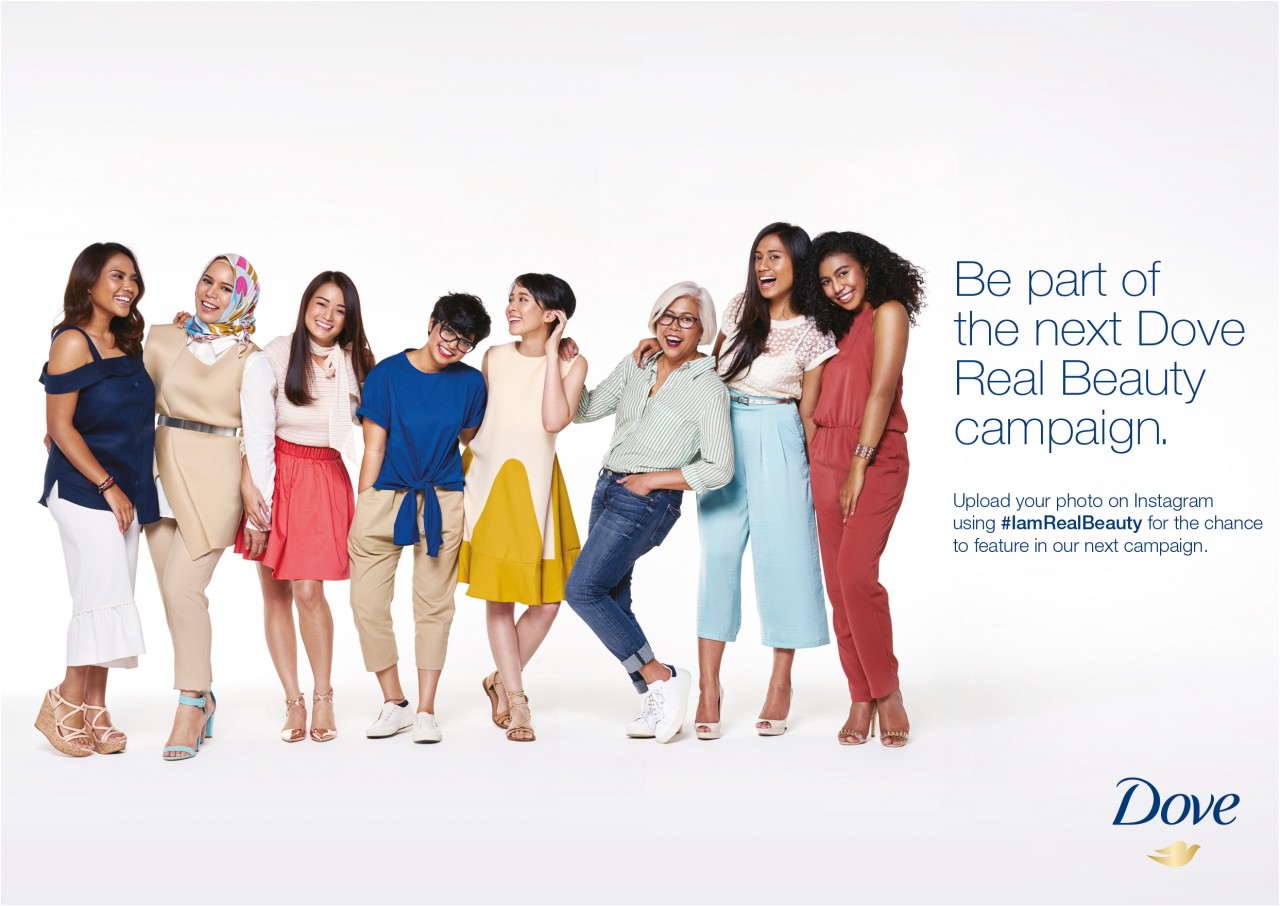
In 2017, Dove Malaysia launched #IamRealBeauty as a hashtag and campaign.
It not only garnered the attention of the online community but also gained Dove the reputation of a brand that truly understands their customers.
👉🏼 By performing social listening, the brand was able to capture accurate portrayals of beauty and contribute to a body positivity movement around the world.
How can you create a hashtag campaign?
1️⃣ Come up with the right hashtag that you want to use for your campaign based on research.
2️⃣ Then use it yourself and ask your followers to do so too. Ideally, you want something unique that does not already have a pile of content under it.
3️⃣ Then go to Prowly and head to the “follow hashtag” option in social media monitoring. This feature allows you to track hashtags across social media.
This can help you in the following situations:
- social impact campaigns
- raising awareness about issues
- promoting specific hashtags
- cooperating with influencers and brand ambassadors (especially if you’ve just sent PR packages)
- tracking individual campaign performance
You can also easily filter all brand results. Simply choose “Mention details” > Keyword is a hashtag and see the results.
Benefits of using hashtag campaigns in social media monitoring
- Hashtag campaigns can be fun and a great way to motivate your customers to create user-generated content UGC
- It’s an easy way to monitor brand mentions
- You can track individual campaigns instead of your general brand presence
- You can expand the reach of your brand
- Increase sales
- And unlock lots of potential for new user-generated content that you can share and reuse
Mitigate and manage crises with social listening
Domino’s crisis management with social listening
In 2009, Domino’s Pizza had a proper brand crisis that started on social media.
Two employees recorded themselves tampering with food and published a video online, reaching millions of users and ultimately hurting the entire brand.
👉🏼 There is a lesson in this situation: much of the crisis could have been averted with proper social listening in place. They would have caught the mishap earlier and could have responded promptly.
Second, Domino’s took a full 48 hours to release a public statement on the matter. By that time, the video had spread like wildfire.
Airbnb #WeAccept social listening hashtag campaign took the wrong turn
Airbnb’s #weaccept campaign was all about the refugee crisis and finding ways to help out. Airbnb promised short-term housing for refugees, immigrants and survivors, and to make donations to this cause.
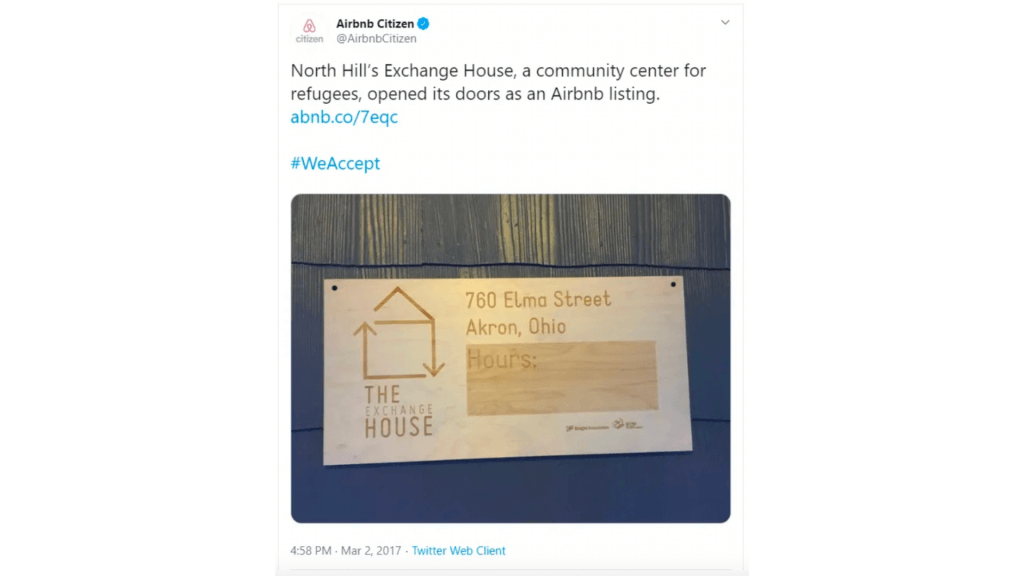
However, the campaign faced some backlash and Airbnb’s brand marketing suffered.
They were accused of discrimination but managed to track the situation every step of the way. By monitoring their hashtag, they were able to react in real-time.
👉🏼 Lesson learned: it’s better to monitor your campaigns to react just on time.
How could social listening help Starbucks mitigate the crisis?
In 2018, Starbucks had an incident where two black men were arrested on their premises for not placing an order. They were held in custody overnight. Someone shot a video and uploaded it online.
Starbucks let the situation slide and issued a brief statement a full day later. The day after that, the company CEO made a statement too but it was too late. The brand reputation had already been harmed.
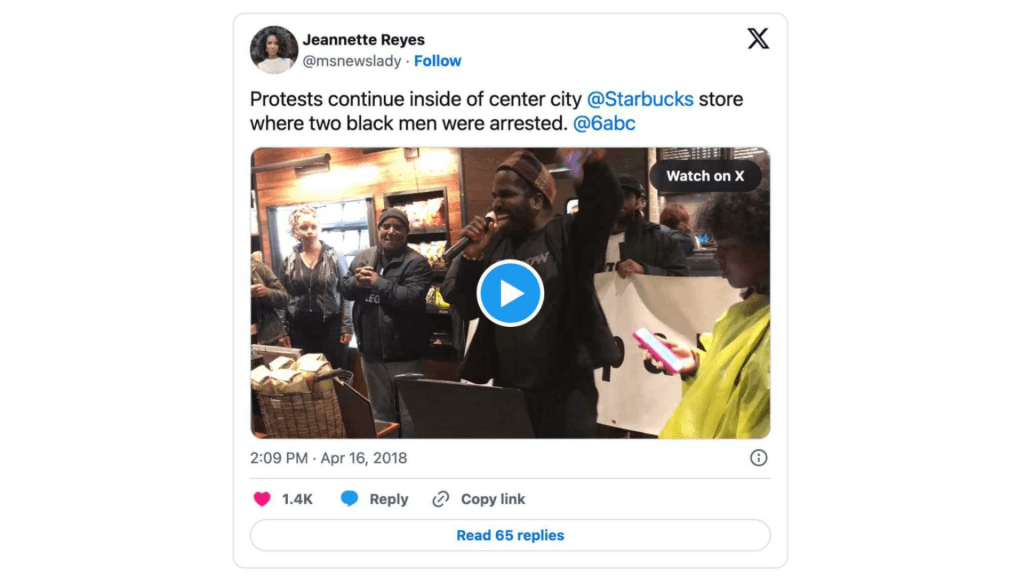
👉🏼 One of the key takeaways from this situation is: being timely matters. When it hits the fan, make sure you are there as a PR professional to clean up your client’s act rather than wait for a full-blown crisis.
FAQ: Benefits of social listening
💬What is social listening?
Social listening involves actively monitoring references to a specific brand or term on various social media platforms and analyzing the context in which they appear. The main focus of social media listening is knowledge, analysis, and understanding.
💬 What is social monitoring?
Social monitoring, on the other hand, is a specific facet of social media listening. It tracks conversations and posts that mention a brand or term, promptly responds to customer comments, and actively engages with the audience.
To learn all about the similarities and differences between social media listening and monitoring, delve into more details in this comparison.
💬 Are there any disadvantages of social listening?
Social listening can be misleading when it is done without any human supervision. While advanced algorithms can pick up terms and keywords automatically, they do not always understand sentiment well. To get the full context of each mention, make sure to double-check them manually too.
Set up your social listening campaign
Social listening is one of the most effective and productive ways to measure online presence for your clients.
It provides real-time notifications about relevant mentions that can help with crisis management, obtaining more information about your key audiences, gaining greater competitive intelligence, enhancing campaign intelligence, and making more data-driven PR decisions.
For PR agencies, the biggest benefit is winning a seat at the table and being able to show the exact return on investment of your PR activities.
The best part is that you can try it completely for free. With Prowly, you have a suite of PR tools for monitoring social media, finding relevant journalists, pitching them and making meaningful connections for your clients all in one place.

